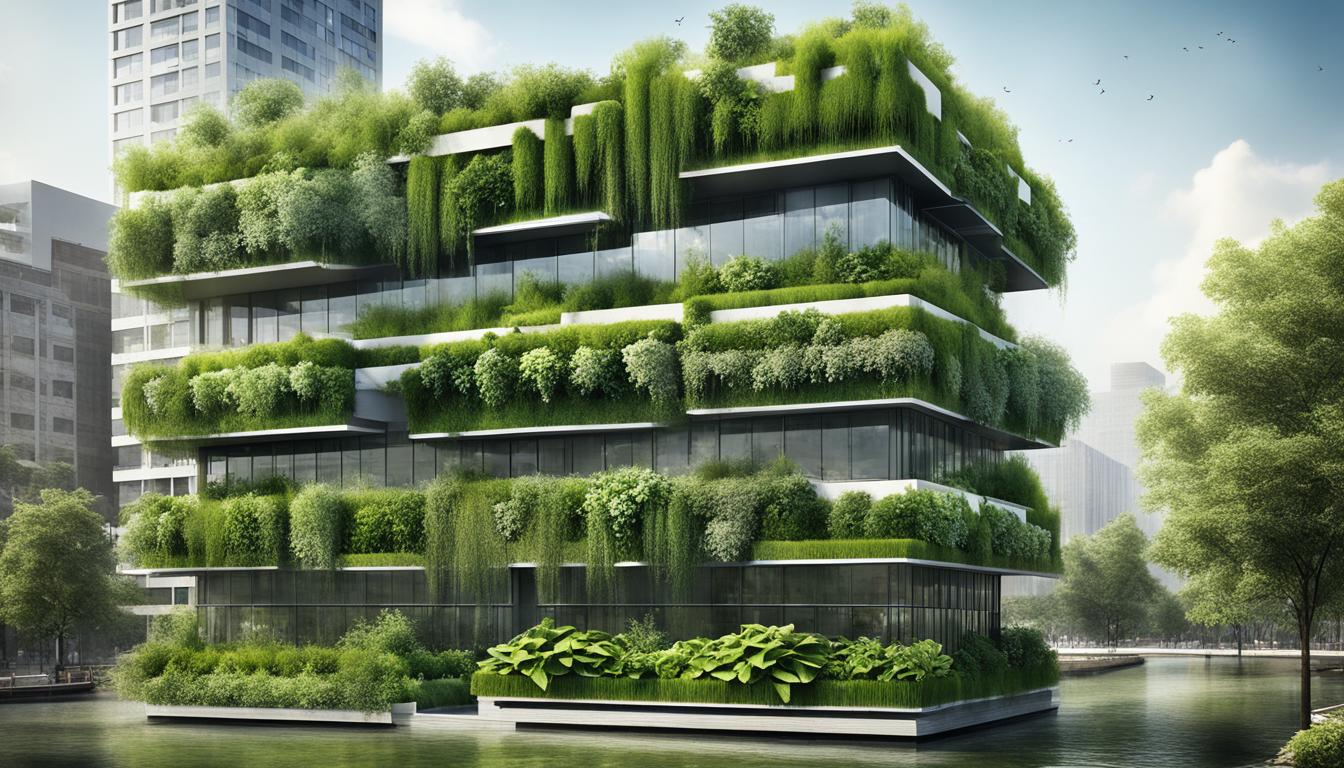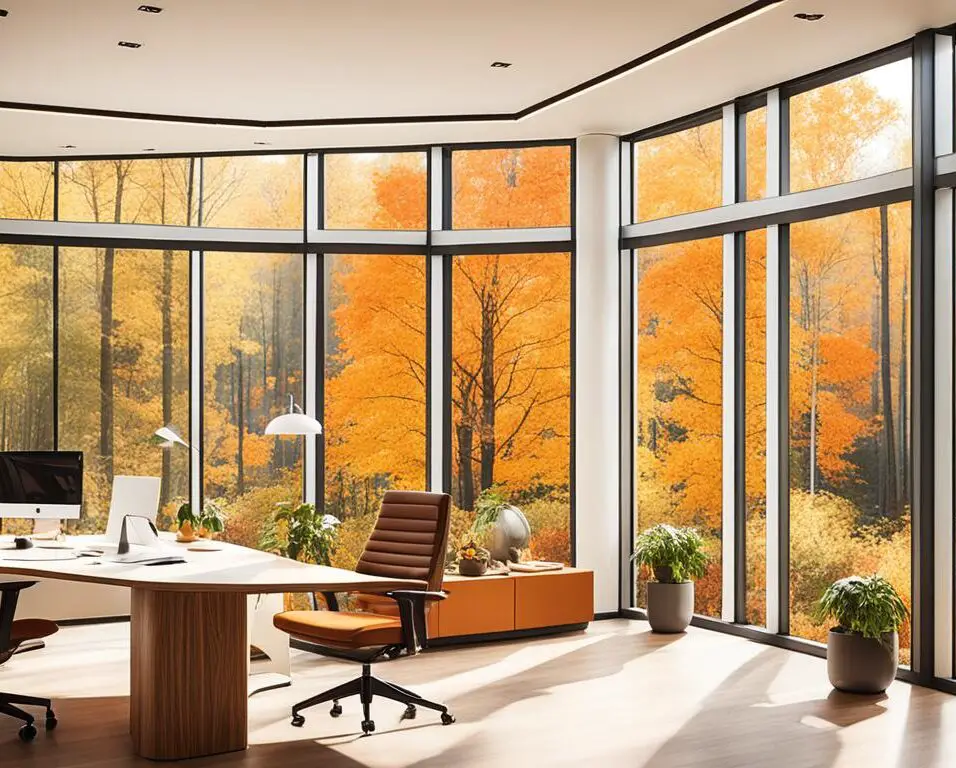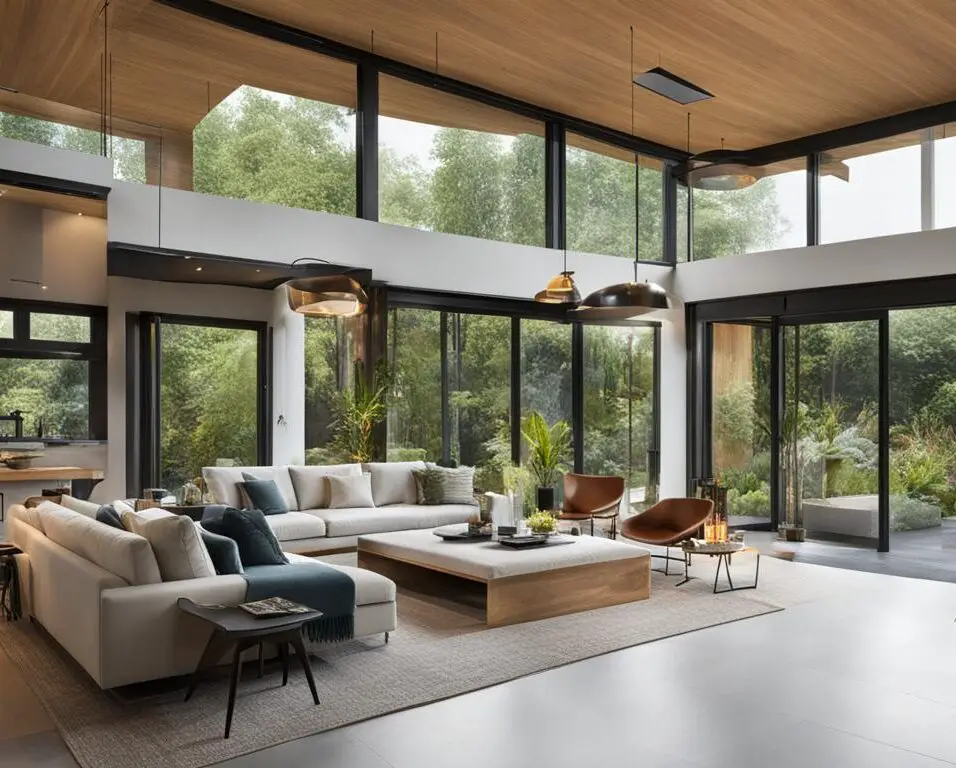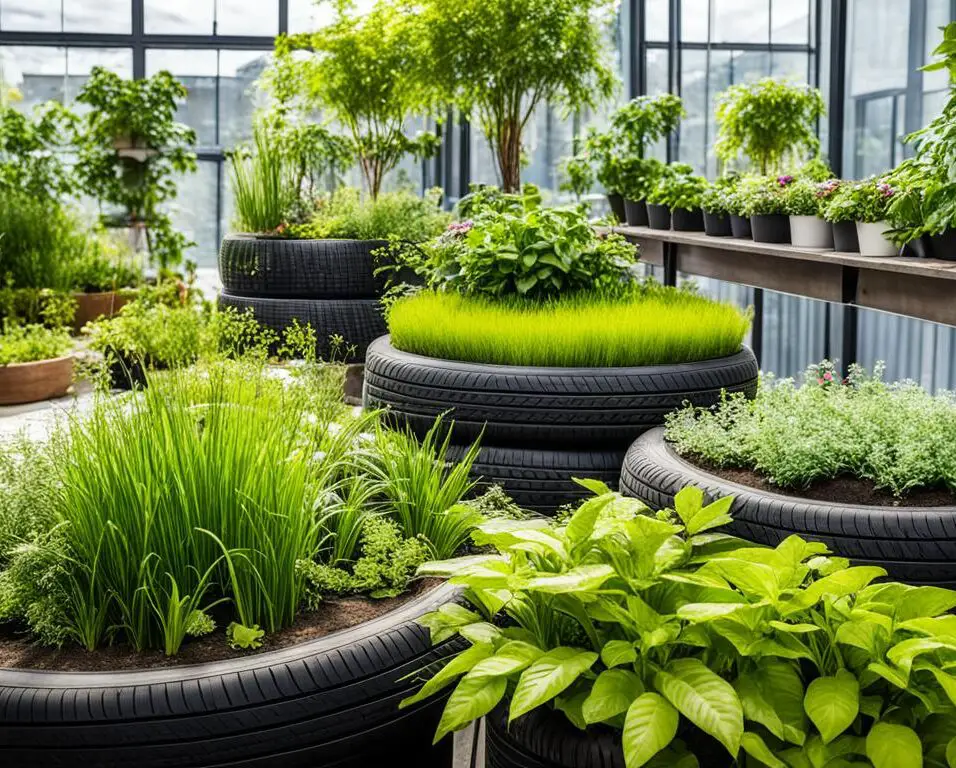Weathering Climate Change: Biophilic Design for Climate Resilience
Climate change poses a significant challenge, requiring us to rethink how we approach construction and design. To address this urgent issue, the concept of biophilic design has emerged as a powerful tool for creating buildings that are not only environmentally friendly but also resilient to the impacts of climate change.
Biophilic design aims to reconnect people with nature by incorporating natural elements into the built environment. This approach benefits both human well-being and the planet, as it promotes sustainable living practices and enhances the resilience of buildings in the face of climate challenges.
By integrating features such as indoor green spaces, natural ventilation systems, and sustainable materials like wood, biophilic design enables us to create climate-resilient structures that optimize energy efficiency, reduce carbon emissions, and promote a healthier and more sustainable future.
Key Takeaways:
- Biophilic design incorporates natural elements into the built environment.
- It promotes sustainable living practices and enhances climate resilience.
- Features like indoor green spaces and natural ventilation optimize energy efficiency.
- Sustainable materials like wood play a crucial role in biophilic design.
- Biophilic design contributes to a healthier and more sustainable future.
Understanding Green Building Certifications
Green building certifications are rating tools used to evaluate building structures based on specific sustainability criteria or standards. These certifications encourage the integration of green building principles into building codes and regulations, promoting greener and more sustainable construction practices. Different certifications have distinct requirements, ranging from energy efficiency and low carbon footprint to performance criteria. Understanding these requirements is essential for guiding projects towards sustainability goals.
By obtaining green building certifications, construction projects demonstrate their commitment to sustainable practices and contribute to a more sustainable future. These certifications provide a framework to assess and measure the environmental impact of buildings, encouraging the use of renewable resources, energy-efficient systems, and environmentally friendly materials. They also consider factors such as water conservation, waste reduction, and indoor air quality to create healthier and more comfortable living and working spaces.
One widely recognized green building certification is Leadership in Energy and Environmental Design (LEED), developed by the U.S. Green Building Council. LEED provides a comprehensive system for evaluating buildings, focusing on areas such as site development, water efficiency, energy efficiency, materials selection, and indoor environmental quality. LEED certification has become a benchmark for sustainable building practices globally.
“Green building certifications enable architects, engineers, and builders to design and construct environmentally responsible buildings that reduce resource consumption and minimize negative impacts on the environment,” said Sarah Greenway, a sustainability expert.
Another prominent green building certification is The Living Building Challenge, administered by the International Living Future Institute. This certification program sets rigorous performance criteria that go beyond traditional sustainability measures, requiring buildings to generate their own renewable energy, harvest and treat their water, and utilize non-toxic materials. The Living Building Challenge aims to create regenerative spaces that restore and improve the environment.
WELL Building Standard is yet another noteworthy certification that focuses on enhancing occupant health and well-being by incorporating elements such as natural daylighting, access to clean air and water, and biophilic design. The WELL certification acknowledges the vital connection between buildings and human health.
Understanding the requirements and benefits of green building certifications is crucial for architects, designers, and construction professionals seeking to create sustainable structures. By adhering to these certifications, they can contribute to a sustainable future and promote environmentally responsible practices within the construction industry.
Benefits of Green Building Certifications:
- Promote sustainable construction practices
- Reduce energy consumption and greenhouse gas emissions
- Enhance indoor environmental quality and occupant comfort
- Encourage the use of renewable resources and environmentally friendly materials
- Create healthier and more productive living and working environments
- Drive innovation in sustainable design and construction
Utilizing Wood for Green Building Certified Projects
Wood, particularly FSC-Certified wood, is a preferred choice for achieving green building certifications. Architects and designers prioritize the use of FSC-Certified wood products as they guarantee ethical sourcing of building materials. Incorporating FSC-Certified products enhances transparency and traceability in the construction process.
When it comes to sustainable solutions for commercial projects, reSAWN TIMBER co. is a trusted provider of FSC-Certified wood products that fulfill the criteria and standards of green building certifications. Their wide range of sustainable wood options ensures that architects and builders have access to high-quality materials while meeting the requirements for green building certifications.
The Benefits of Wood in Green Building Certified Projects
- Renewable Resource: Wood is a sustainable material that can be harvested and replenished, making it an environmentally friendly choice.
- Carbon Sequestration: Trees absorb carbon dioxide from the atmosphere, helping to mitigate climate change.
- Energy Efficiency: Wood has excellent thermal insulation properties, reducing the need for excessive heating or cooling.
- Biophilic Design: Incorporating wood into buildings creates a connection with nature, improving occupant well-being and productivity.
By utilizing wood in green building certified projects, we can create sustainable environments that benefit both people and the planet. The use of FSC-Certified wood ensures responsible sourcing, promoting a more ethical and transparent construction industry.
With a commitment to sustainability, reSAWN TIMBER co. offers innovative wood products that not only meet the strict requirements of green building certifications but also contribute to a more sustainable future. By choosing wood as a primary building material, we can create structures that are not only visually appealing but also environmentally responsible.
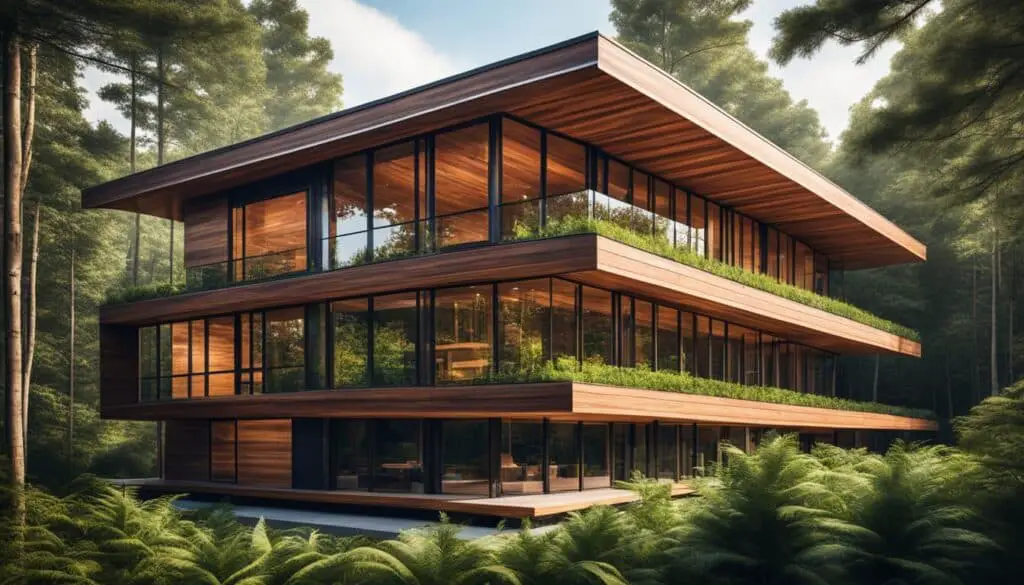
The Benefits of Thermal Modification in Wood
Thermal modification is a process that transforms wood into a material with improved durability, stability, and aesthetics. It involves altering wood using heat energy without the use of additional chemicals. The process induces structural changes within the wood, enhancing its properties without risking combustion.
Thermal modification alters the cellular characteristics of wood, leading to several benefits:
- Improved Dimensional Stability: Thermal modification reduces the wood’s susceptibility to moisture absorption, resulting in enhanced dimensional stability. This makes it an ideal choice for applications where exposure to fluctuating environmental conditions is expected.
- Increased Durability: The modified wood exhibits increased resistance to decay, making it more durable and long-lasting. It can withstand a wide range of environmental conditions, ensuring its longevity in various applications.
- Enhanced Aesthetic Qualities: Thermal modification enhances the natural coloration of wood, resulting in a darker and more uniform appearance. This aesthetic improvement adds to the visual appeal of wood products, making them a popular choice for both interior and exterior applications.
- Reduced Environmental Impact: As thermal modification does not require the use of additional chemicals, it is a more environmentally friendly option compared to alternative wood treatment methods. This makes it a sustainable choice for those seeking to minimize their ecological footprint.

Incorporating thermally modified wood into construction projects offers numerous advantages, from improved durability and stability to enhanced aesthetic qualities. It provides a sustainable and visually appealing option for those seeking environmentally friendly building materials.
| Benefits of Thermal Modification in Wood | Description |
|---|---|
| Improved Dimensional Stability | Reduces susceptibility to moisture absorption, resulting in enhanced dimensional stability |
| Increased Durability | Enhanced resistance to decay and ability to withstand various environmental conditions |
| Enhanced Aesthetic Qualities | Natural coloration of wood is improved, leading to a darker and more uniform appearance |
| Reduced Environmental Impact | Thermal modification process does not require additional chemicals, making it more environmentally friendly |
Thermally Modified Wood for Cladding Applications
Thermally modified wood has emerged as a sought-after option for wood cladding due to its enhanced durability, stability, and resistance to decay. This makes it an ideal choice for exterior applications where the wood is exposed to environmental elements.
Two notable examples of thermally modified wood species commonly used for cladding are SylvaTM and Abodo®. SylvaTM is made from North American Red Oak and retains its natural grain patterns while gaining increased resistance to decay, insects, and environmental factors. Abodo Vulcan thermally modified wood cladding, crafted from sustainably sourced New Zealand plantation timber, offers superior stability and reduced resin content.
The Advantages of Thermally Modified Wood Cladding
Choosing thermally modified wood for cladding applications offers several advantages:
- Enhanced Durability: Thermally modified wood undergoes a process that alters its cellular structure, resulting in improved resistance to decay, insects, and weathering effects.
- Stability: The thermal modification process reduces the wood’s susceptibility to moisture absorption and dimensional changes, ensuring greater stability over time.
- Aesthetics: Thermally modified wood develops a darker and more uniform appearance, enhancing its visual appeal and complementing various architectural styles.
“Thermally modified wood cladding provides enhanced durability, stability, and a distinct aesthetic appeal, making it an excellent choice for architects and designers.”
With its remarkable performance characteristics, thermally modified wood cladding offers a sustainable and visually striking solution for both residential and commercial projects. Its ability to withstand the elements while maintaining its natural beauty makes it an ideal choice for architects and designers seeking a reliable and aesthetically pleasing material for exterior applications.
| Brand | Wood Species | Key Features |
|---|---|---|
| SylvaTM | North American Red Oak | Retains attractive grain patterns Enhanced resistance to decay, insects, and environmental factors |
| Abodo® Vulcan | New Zealand plantation timber | Superior stability Reduced resin content |
The Evolution of Facility Management
As facility management continues to adapt to the ever-changing needs of buildings and occupants, the integration of automation, resilience, and human-centered innovations has become crucial. Automation and AI technologies have revolutionized the way buildings are managed, from predictive maintenance to streamlined operations. This advancement allows facility managers to optimize resource allocation, improve energy efficiency, and enhance the overall performance of the facility.
Resilience and adaptability have also become key considerations in facility management. With the increasing frequency of natural disasters and unexpected challenges, buildings need to be able to withstand such events while minimizing disruption. Integrating resilience into facility management practices ensures that buildings are equipped with systems and processes that can swiftly respond, recover, and continue operations in the face of adversity.
However, facility management is not solely focused on automation and resilience. Human-centered innovations play a vital role in creating spaces that prioritize the well-being and satisfaction of occupants. Incorporating elements like biophilic design, wellness-centric spaces, and flexible work environments enhances the productivity, satisfaction, and overall experience of individuals within the facility.
By embracing facility management’s evolution, organizations can unlock the potential for increased efficiency, resilience, and occupant satisfaction. The integration of automation, resilience, and human-centered innovations paves the way for a future that prioritizes sustainability, adaptability, and the well-being of all stakeholders.
Key Takeaways:
- Automation and AI technologies have transformed facility management, enabling predictive maintenance and streamlining operations.
- Resilience is essential in facility management to ensure buildings can withstand unexpected challenges like natural disasters.
- Human-centered innovations, such as biophilic design and wellness-centric spaces, enhance occupant well-being and productivity.
- The integration of automation, resilience, and human-centered innovations offers opportunities for increased efficiency and occupant satisfaction.
Conclusion
In conclusion, the future of facility management lies in the seamless integration of automation, resilience, and human-centered innovations. Automation and artificial intelligence offer powerful tools to enhance efficiency and adaptability, enabling facility managers to streamline operations and optimize resource allocation. However, it is crucial to maintain a human-centered approach, ensuring that these advancements serve the needs and well-being of the people who utilize the facilities.
Resilience and adaptability are essential in the face of unpredictable challenges, such as natural disasters or unforeseen events. By leveraging automation and AI technologies, facility managers can improve preparedness and response, mitigating potential risks and minimizing downtime. The combination of automation and resilience creates a foundation for robust facility management practices.
Moreover, human-centered innovations play a pivotal role in shaping the future of facility management. Designing spaces that prioritize the well-being and productivity of occupants through elements like biophilic design and wellness-centric areas fosters a positive and conducive environment. By understanding and meeting the needs of the people using the facilities, facility managers can promote greater satisfaction, productivity, and overall satisfaction.
By embracing the interconnected nature of automation, resilience, and human-centered innovations, facility management can pave the way for an efficient, resilient, and people-centric future. By optimizing operations through automation, preparing for unexpected challenges through resilience, and creating spaces that enhance well-being through human-centered innovations, facility managers can lead the way in sustainable and forward-thinking facility management practices.
FAQ
What are green building certifications?
Green building certifications are rating tools used to evaluate building structures based on specific sustainability criteria or standards. These certifications encourage the integration of green building principles into building codes and regulations, promoting greener and more sustainable construction practices.
Why is wood a preferred choice for achieving green building certifications?
Wood, particularly FSC-Certified wood, is a preferred choice for achieving green building certifications. Architects and designers prioritize the use of FSC-Certified wood products as they guarantee ethical sourcing of building materials. Incorporating FSC-Certified products enhances transparency and traceability in the construction process.
What is thermal modification in wood?
Thermal modification is a process that transforms wood into a material with improved durability, stability, and aesthetics. It involves altering wood using heat energy without the use of additional chemicals. The process induces structural changes within the wood, enhancing its properties without risking combustion.
Why is thermally modified wood suitable for cladding applications?
Thermally modified wood has gained significant attention as an excellent option for wood cladding. It offers enhanced durability, stability, and resistance to decay, making it well-suited for exterior applications. SylvaTM and Abodo® are examples of thermally modified wood species used for cladding.
How is facility management evolving?
Facility management is evolving with the integration of automation, resilience, and human-centered innovations. Automation and AI technologies are revolutionizing how buildings are managed, from predictive maintenance to streamlined operations. Resilience and adaptability are crucial to ensure buildings can withstand unexpected challenges such as natural disasters. Human-centered innovations focus on creating spaces that enhance the well-being and productivity of the people who use them, incorporating elements like biophilic design and wellness-centric spaces.
How do automation, resilience, and human-centered innovations contribute to facility management?
The interconnectedness of automation, resilience, and human-centered innovations is key to the future of facility management. Automation and AI provide tools for efficiency and adaptability, while a human-centered approach ensures these advancements serve the needs of the people. Resilience and adaptability prepare buildings for the unpredictable, leveraging automation and AI for better-prepared responses. By embracing these pillars, facility management can shape a future that is efficient, resilient, and centered on the well-being of people.



